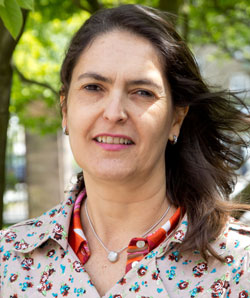Heloisa N. Bordallo receives Carlsberg grant for state of the art equipment
Associate professor Heloisa N. Bordallo at the Niels Bohr Institute (NBI), University of Copenhagen, has been awarded a grant from the Carlsberg Foundation, enabling her and her research group to acquire an advanced Raman microscope. Her research group has had great success in recent years developing a line of research based on understanding the inner workings of the smallest components in extremely diverse areas, such as cell-biology, pharmaceuticals, vaccine-delivery, cancer research and the cement needed for modern, green construction.
The possibility to perform ultra-fast Raman imaging, and subsequent development of a multidisciplinary lab at the Niels Bohr Institute, will enable the researchers to venture even deeper into the matter that makes up everyday life for all of us, and expand their methods and results even further, to the benefit of a great many people.
A powerful tool for an already very adept and diverse research group
The quest for developing new technologies to heal diseases and enhance our quality of life requires the understanding of the underlying phenomena that lead to the desired physical, chemical and biological properties. Under this heading, the research of Assoc. Prof. Heloisa N. Bordallo at the X-rays and Neutron Section at the NBI has been very successful in areas of science that have a very direct impact on our daily-life. This has contributed to the development of an impactful multidisciplinary research program at the NBI. With the highly advanced 3D Raman imaging equipment, that allows identification and visualization of the spatial distribution of the molecules in a sample, an advanced microspectroscopic imaging laboratory will be set up at NBI. This new capability will greatly contribute to the understanding of the basic elements in areas as different as construction materials, waste management, pharmaceuticals and cellular behavior.
Spectroscopic microscopy is completely non-destructive

“I hope that the equipment will arrive on September 2020 and we will be up and running by the end of October. This will enable us to do imaging combined with spectroscopy. If, for instance, there is an interaction between a drug and a particular part of the cell, we can check the interaction very precisely, right down to the interaction between the molecules in the drug and the molecules in the cell”, Heloisa N. Bordallo explains. Archeological artefacts represent another field, in which the imaging technique will be efficient. “The thing is, this technique is completely non-destructive and fully compellent other imaging techniques, such as neutron and X-rays imaging. We don’t have to chip a piece off of a precious, ancient vase to find the components of the colour used in the glaze – or peel the layers off a painting to investigate it. We can see the individual molecules everything is made of, literally without touching the item we are researching. This makes the technique feasible for a number of different branches of research”, she explains.
“But obviously, I have a few wishes for my own use” Heloisa N. Bordallo says. “First of all, I want to open up the new laboratory for a series of interdisciplinary research. Other researchers should be able to come here and perform Raman spectroscopy and imaging experiments, and this interdisciplinarity will benefit us all. We have already seen that happen quite a few times with our recent work in Hepatitis B vaccine, the waterflow in the cells or the setting of dental cements, when applying techniques from physics on biology and dentistry. Secondly, I want to look deeper into pharmaceuticals. We are constantly looking for more efficient drugs, but it can be difficult to tell exactly what the interaction between the drug-molecule and the cell is. Now, we’ll be able to check out complementary effects of, for instance, how a chemo therapy drug acts locally, in a very specific part of a cell line”.
Interdisciplinarity is key
A few years ago, Heloisa Bordallo received another grant from Carlsberg, also for equipment. The instrumentation for thermo analysis she got back then is very good for educating students. Being able to perform imaging analysis at the NBI, also used in different private businesses and hospitals, will boost even more the qualifications of our students. Another very important aspect of the interdisciplinarity is the fact that Bordallo plans to contact researchers at other faculties like HEALTH and suggest collaborations, and it will strengthen even further the research at the Niels Bohr Institute. Interdisciplinarity keeps demonstrating its potentials, she says. “People must know we have this instrument and are open to both academic and industrial collaborations. More importantly, it we will extend our students education”.
See also:
Contact
Heloisa Nunes Bordallo, Associate Professor
Xray and Neutron Science
Email: bordallo@nbi.ku.dk
Mobile: +45 21 30 88 29
